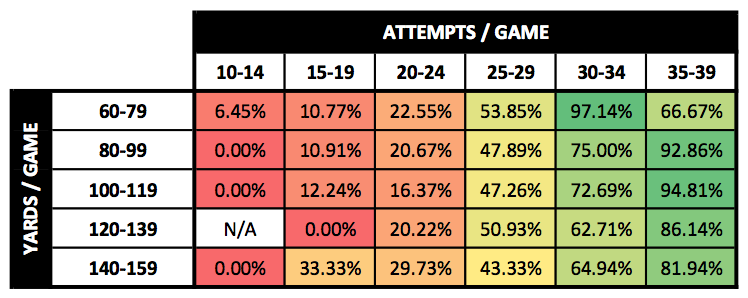
 In response to the low yards per attempt by Alex Green last weekend, we had some good discussion in the comments regarding my statistical research on how the rushing game affects the success rate of NFL teams in the past ten years. The data seemed to show that the number of attempts had a higher correlation with winning than average yards per attempt.
In response to the low yards per attempt by Alex Green last weekend, we had some good discussion in the comments regarding my statistical research on how the rushing game affects the success rate of NFL teams in the past ten years. The data seemed to show that the number of attempts had a higher correlation with winning than average yards per attempt.
Some people agreed, bringing up the Packers’ success during the two halves of the Seahawks and Colts games when they committed to running the ball more. Others argued that this was more of a secondary outcome, in which winning causes increased attempts and not the other way around.
We even had some suggestions for further statistical research, such as parsing out big runs and even comparing correlations in the passing game.
Before continuing my future research, I wanted to do a quick aggregate of both total attempts per game and total yards per game. These two categories showed a higher correlation to winning than yards per attempt, so what if we looked at them together?
Below is a table that charts win percentage in relationship to both attempts and yardage. Take a look:

First and foremost, this was an outcome I did not expect at all. Logic told me that we’d see more of a “diagonal” relationship with win percentages. In other words, the higher the yards and attempts combined, the better the percentage.
But that didn’t happen at all. Instead, we see a reinforcement of the idea that total attempts matters more than anything else. If you look vertically across the chart, you’ll notice that the success rate is more consistent by column rather than by row or diagonally.
Honestly, one of the things that really stunned me was the 97.14% success rate where teams had only 60-79 yards and 30-34 attempts in a game. That’s at worst a 1.76 YPC and at best a 2.63 YPC.
I’d also like to note that most of these percentages are based on at least 100 games that match the criteria. So we’re not really looking at small sample sizes across the board.
I’m interested in hearing your comments. What do you make of this, and how does it apply to our ongoing conversation?
——————Chad Toporski, a Wisconsin native and current Pittsburgh resident, is a writer for AllGreenBayPackers.com. You can follow Chad on twitter at @ChadToporski
Follow @ChadToporski——————

It does seem to confirm that winning teams make more rush attempts. whether that is the cause or effect of success remains to be seen. I agree that yards per attempt does not seem to have a corellation otherwise we would see increasing success as yards per attempt increase.
I think we also need to consider a factor that would skew ypc higher on losing teams. if a team is about to lose, the other team is likely to be in prevent-defense, which would naturally allow higher ypc in those situations. ypc across an entire game doesn’t seem to mean much.
it would be interesting to see the corellation if we could somehow remove all the ypc stats accurring at points in a game when there is a difference in score between the 2 teams. if the game is tied, neither team would have an incentive to rush solely for the sake of running clock, and we would get a more true picture of ypc vs. team success.
So getting 60-79yds on 30-34 attempts with a 97% win would indicate the passing game was very effective and the run attempts allowed for chunk yardage on pass plays and a high 3rd down success rate and possession time was lopsided.
This would be a senario for the Packers weekly ‘if’ our defense didn’t go to the ‘soft’ scheme and allow opposing scores as easy and quick as seen too often.
Would MM run 30+ a game..why not,as long as the mix keeps a 3rd and short for the pass…clock killing without a 100yd rushing stat.
However,if the average game score was 13-10…it’s likely neither team could pass at all.
These stats are produced from NFL data between 2002-11, so theyw represent the current “pass happy” game. Stats can be a miss-representation of reality, some times, due to outside factors. However,even though these stats may have some outside factors effecting them, they are to one sided to not suggest they are accurately pointing out a trend (more carry’s, not yards, correlate with wins). This a powerful graft , and a bit of a surprise.
Please send this data to MM, although I beleave he has caught on to this already.
I’m not sure if you can filter for this, but would it be possible to re-analyze the data to only include games where there was only a 7-point differential in score between the two teams in the 4th quarter? My reasoning is that if the game is a blowout, rushing efficiency is secondary to running out the clock. That could be why teams that run a lot and but not get a lot of yards seem to have a great winning percentage.
Questions and thoughts: I would assume there is an inversely proportional relationship between attempts and scoring, but I’m not sure. Running more often would serve to limit the passing of the other team. Time of possession would likely be related to attempts. Finally, would the difference between winning and losing team attempts bear any results?
Great job responding to comments! Interesting that you call winning percentage “success rate,” it is a term that has been used for a slightly different purpose.
http://www.advancednflstats.com/2010/10/how-coaches-think-run-success-rate.html
Sorry if I sound like a shill for that site. I am not affiliated with it in any way, just think it has some interesting analysis. Happy to discuss the ideas further.
i would guess that if the per carry average is low and attempts are high at games end, that would mean that you are playing with a sizeable lead. if you are losing then you are not going to stick with a run game that is not effective. there is no way that you will have that many attempts for so few yards in a losing effort/close game.